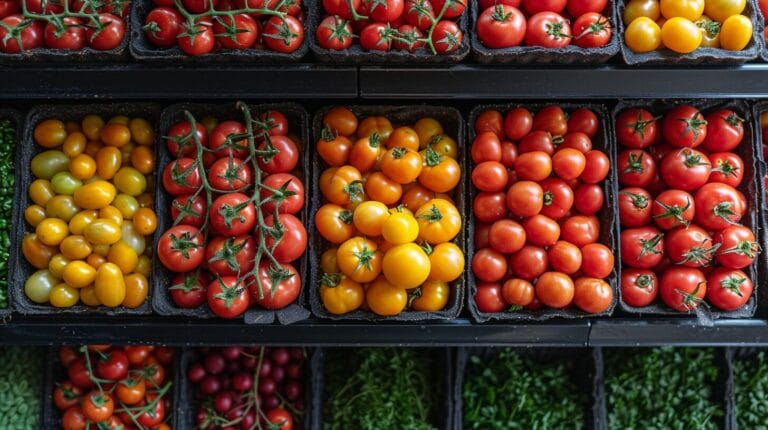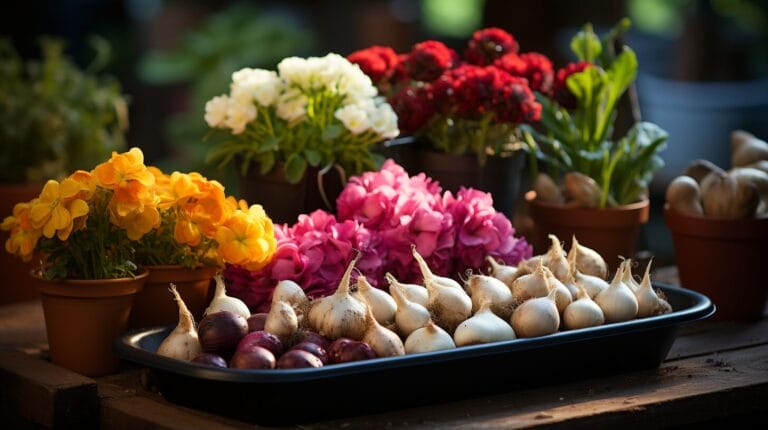Types of Kale Plants: Selecting the Best Kale Varieties to Grow
Once viewed as a common green vegetable, Kale has remarkably climbed the ranks to secure its place as a prized member of the vegetable family. Its culinary acclaim is not just due to its rich nutritional content, but also its adaptability in the kitchen. The variety of Kale types is expansive. From the almost black-toned Black Magic leaves to the intense Dazzling Blue, each variety has its unique characteristics- with some displaying a piquant flavor, some leave a sweet finish, and some possess hues so lively they could be mistaken for a work of art.
The experience of growing kale, nurturing it from seedling to harvest, feels almost like watching your children grow up. As you embark on this gardening journey, you’ll unravel more than just fresh produce; you’ll discover flavors that hit notes you didn’t know were missing. So let’s dive into the lush landscape of kale – from understanding its rise to popularity, exploring various varieties, the nutritional benefits they offer, and how to incorporate them into your meals.
Key Takeaways
- There are many types of kale, each with unique flavors and textures. Some examples include Black Magic, Dazzling Blue, Winterbor, Red Russian, and Lacinato.
- Kale is a tough plant that can grow in cold weather. It’s packed with vitamins A, C, and K, calcium, iron, and antioxidants, which are good for your health.
- When choosing kale to grow at home or use in the kitchen, consider how it tastes (sweet or bitter), the texture (curly or flat leaves), and how it looks (colorful or dark greens).
- You can eat different kinds of kale raw in salads or cook them in various dishes. Baby kale is tender for salads; others, like curly kale, make crispy chips when baked.
- When planting kale, include lots of compost-rich soil to help it grow big and strong. Remember to pick the leaves at the right time: young ones for salads and mature ones for cooking.
Understanding the Basics and Rise of Kale
Kale’s rise from obscure leafy green to a kitchen staple is a story of taste and tenacity. From curly kale, with its characteristic wrinkles, to the lacinato or “dinosaur” kale with flat leaves and the vibrant, colorful Russian kale, a variety suits every palate. With at least 15 well-known varieties like Black Magic and Redbor, the world of kale offers a wealth of flavors and textures for gardeners to explore.
Introduction to Kale
I love cultivating kale in my garden. This green leafy is a plant that people have been farming for over 2,000 years. It comes in many shapes and colors. You can find curly kale with many wrinkles, lacinato or “dinosaur” kale with flat leaves, colorful Russian kale, and even tiny baby kale good for salads.
Kale is famous because it’s strong against the cold, and you can grow many different kinds. There are at least 15 well-known types, like Black Magic and Redbor. Gardeners like me enjoy trying out these varieties to see which one grows best or tastes the sweetest in their own backyards.
Popularity of Kale
Kale has taken kitchens by storm and become a favorite for many. It’s good for you and fits right into healthy meals. People have found lots of ways to eat kale – in salads, smoothies, soups, and even as crispy chips.
This green leafy is now famous because it contains nutrients like vitamins C and K.
Baby kale is really popular, too. It tastes sweeter and milder than grown-up, making it perfect for raw dishes or folks just starting to try greens. Chefs love using different types of kale to add color and taste to their plates.
Now, more people grow their own kale at home because they know how easy it can be.
Uniqueness of Each Variety
Every variety of kale brings a special touch to the garden and kitchen. Think about it like choosing clothes—each piece has a different color, pattern, and fit for various occasions.
With 15 popular kale cultivars, you get an amazing mix of colors from green to purple, smooth to curly textures, and sweet to peppery flavors. Some kales love the cold; others grow fast in warmer seasons.
You might pick ‘Dazzling Blue’ for quick-growing leaves that add a splash of color with their blue-ish tones. Or maybe you want tiny tender leaves quickly; then baby kale is your go-to choice because it’s easy to grow and super yummy in salads.
Every kind has something cool about it—curly kale packs lots of healthy compounds called glucosinolates, while red ones have extra anthocyanins that are good for your body, too! Each type needs its own care, but don’t worry—they all share one thing: they’re not fussy plants and will happily grow if you give them some love!
Top Types of Kale Plants to Grow
Growing kale is an invitation to explore an array of fascinating varieties, each with its unique charm and benefits. Some of the top cultivars to consider for your garden include:
| Variety | Flavor Profile | Texture | Maturation Period | Best Usage |
|---|---|---|---|---|
| Black Magic | Mildest flavor | Deeply savoyed leaves | 60-65 days | Cooking, Juicing |
| Dazzling Blue | Sweet with nutty undertones | Serrated blue-green leaves | 30-60 days | Salads, Sauteeing |
| Winterbor | Robust, traditional kale flavor | Curly, frilly leaves | 55-60 days | Braising, Soups |
| Redbor | Earthy with a hint of pepper | Frilly, deep purple leaves | 55-60 days | Garnishes, Colorful Salads |
| Red Russian | Ultra sweetness in cold weather | Flat, oak-shaped leaves | 50-60 days | Raw in Salads, Light Cooking |
| Blue Curled Scotch | Mild and slightly bitter | Curly, blue-green leaves | 30-55 days | Salads, Chips |
| Nero di Tuscana (Lacinato) | Earthy and nutty | Bumpy, dark green leaves | 30-65 days | Soups, Stews |
| Siberian | Sweet and tender | Smooth, broad leaves | 40-50 days | Salads, Gentle Cooking |
| Bear Necessities | Delicate and sweet | Fine, cut leaves | 25-30 days | Salads, Light Sauteeing |
Each kale variety brings something unique to your kitchen, whether it’s for a fresh salad or a hearty stew. Remember, the right variety can elevate your dishes while providing substantial nutritional benefits.
Understanding Kale Varieties: Factors to Consider
When selecting a kale variety, consider its climate suitability, taste preference, available space, soil health, your cooking plans, harvest time, color, plant height, and the specific health benefits it offers.
Following these considerations will ensure you pick the best kale for your garden and culinary needs.
Planting Basics
Once you’ve chosen your kale, here are some steps to get your garden started:
- Choose the right time: Plant kale in early spring or late summer. Kale loves cool weather and can handle a little frost.
- Select a sunny spot: Kale needs about 6 hours of sunlight daily.
- Prepare the soil: Ensure the soil is loose and drains well. Mix in compost for nutrients.
- Space seeds or plants properly: Plant seeds half an inch deep and 3 inches apart or young kale 12 inches apart.
- Water well: Keep the soil moist as it grows.
- Protect from pests: Use row covers if bugs are a problem.
- Fertilize carefully: Add natural fertilizer occasionally. Too much can be harmful.
- Harvest at the right time: Pick young leaves when they’re small for salads or wait until they’re bigger for cooking.
Diving into Unique Varieties
Unique kale varieties offer a world of textures and flavors that can elevate your culinary palette and garden aesthetic. For instance, curly kale’s vibrant, crunchy texture makes it ideal for salads, while Siberian kale’s hardiness makes it a top pick for gardeners in chilly weather. Ornamental and flowering kale can add a pop of color to your garden and plate, while walking stick kale, which can grow up to 5-6 feet high, is a showstopper in the garden.
3 Popular Kale Plant Varieties to Grow (Best to Worst)
Curly Kale
I love growing curly kale in my garden. Its tight, curled edges give salads a beautiful look and crunchy texture. This kind of kale is very popular, probably because it’s easy to find at the store and adds a bold, peppery flavor to dishes.
It comes in deep blue-purple colors that make your plate pop!
Curly kale is not just pretty; it’s packed with good stuff for your body, too. Full of antioxidants, this leafy green fights off harmful things in our bodies and keeps us feeling strong.
With 21 different types of kale out there, curly kale stands out as one you should definitely try. Whether I toss it fresh into a salad or cook it up for dinner, curly kale brings health and taste to my table every time!
Siberian and Russian Red Kale Siberian Kale
Siberian and Russian Red Kale Siberian kale bursts with hardiness, eager to grow when the cold sets in. Its leaves stay tender even through frosty nights, making it a top pick for gardeners who face chilly weather.
A sweet flavor emerges after a light freeze, surprising those who expect the typical bitterness of leafy greens.
Russian Red Kale stands out with its red-veined, green leaves that add a pop of color to your garden and plate. It’s not just pretty; this variety can resist pests better than many others.
You’ll find that Russian Red brings a slightly peppery taste, which makes it perfect for adding zing to salads or cooking hearty dishes.
Ornamental & Flowering Kale
Ornamental and flowering kale are like the fancy dresses of the garden. They show off with big, bold leaves that can be purple, pink, white, or green. These types are not just pretty; you can eat them too! They’re tough plants and can handle cold weather really well.
When folks use them in cooking, they usually cook them for a long time to help with their bitter taste.
I love adding ornamental kale to my garden because it looks great and adds color throughout fall and winter. Even when it’s chilly outside, these plants keep my garden looking bright.
And if I want something different for dinner, I’ll pick some leaves and stir them into a hearty soup or stew where their strong flavor makes the dish even better. Now let’s talk about how full of good stuff kale is for your body!
Nutritional Benefits of Kale
Kale is a nutritional powerhouse packed with vitamins and minerals that fortify the body. Each variety offers unique health-boosting attributes, from curly kale, rich in glucosinolates, to Siberian and Red Russian kale, high in anthocyanin content. Despite their nutritional differences, all kales are a great source of vitamins A, C, and K, as well as calcium, iron, and fiber.
Nutrient Profile
Understanding the nutrient profile of different types of kale is essential for selecting the best type that aligns with your dietary needs and gardening aspirations. These leafy greens pack a potent punch of vitamins, minerals, and other beneficial compounds. Here’s a detailed look at the nutritional benefits that kale brings to the table, summarized in an informative table for quick reference.
| Nutrient | Curly Kale | Siberian Kale | Red Russian Kale | Ornamental Kale | Lacinato Kale |
|---|---|---|---|---|---|
| Vitamin A | High | High | High | High | High |
| Vitamin K | Very High | Very High | Very High | Very High | Very High |
| Vitamin C | High | High | High | Moderate | High |
| Antioxidants | High (Glucosinolates) | Moderate | High (Anthocyanins) | Moderate | Moderate |
| Calcium | Good | Good | Good | Good | Good |
| Fiber | Good | Good | Good | Good | Good |
| Iron | Good | Good | Good | Good | Good |
| Flavor Profile | Bitter, Peppery | Sweet, Mild | Sweet, Nutty | Mild, Sweet | Earthy, Nutty |
Curly kale, rich in glucosinolates, offers a distinct bitter and peppery flavor that adds a punch to any dish. Siberian and Red Russian kale, with their higher anthocyanin content, not only add vibrant color to your garden but also a sweeter, more nuanced taste to your meals. Although ornamental kale is often grown for its aesthetic appeal, it too can serve as a nutritious addition to the plate. Lacinato kale, recognized for its earthy and nutty flavor, provides a hearty texture and a wealth of nutrients.
Remember that the intensity of flavor and texture can slightly change when cooked, allowing for diverse culinary applications. Whether you’re crafting a salad, a hearty stew, or simply sautéing greens, a kale variety will meet your palate preferences while contributing impressive nutritional value.
Lacinato Kale Benefits
Lacinato kale is a superfood that gives your body lots of good stuff. It’s packed with vitamins A, C, and K and has few calories. This means you can eat a lot without worrying about weight gain.
Your heart will love this kale because it has special nutrients called flavonoids, which keep your heart strong.
This type of kale also helps build strong bones thanks to calcium and keeps your muscles working well with magnesium. Potassium in this kale takes care of your nerves and ensures they send messages properly around the body.
And guess what? Lacinato kale is full of fiber, so your stomach stays happy and works like it should.
The taste of lacinato kale is kind of earthy and a bit bitter—this makes it great for many different recipes. You can throw some into salads or cook it up for dinner; its sturdy leaves hold up well when heated.
Now, let’s talk about how to make those tasty leaves part of your meals at home!
Varietal Differences
Kale comes in many shapes and flavors, each with special nutrients. Some contain vitamins A and C, while others contain more calcium or iron.
The taste can vary, too; some kale is bitter, but others can be sweet, especially after a frost. This means you can choose which kale to grow or eat.
Curly kale is great for crispy chips because the edges are crunchy when baked. On the other hand, Lacinato kale, also known as Tuscan kale, has dark blue-green leaves that are super for salads and smoothies.
Every variety has something different to offer – from color to texture to taste!
Which Types of Kale Plants are Resistant to Small White Flower Weed?
While there are several types of kale plants available, not all of them are resistant to types of small white flower weeds. It’s important to choose kale varieties that have been specifically bred to combat these pesky intruders. Opt for varieties known for their resilience against small white flower weeds to ensure a successful and abundant kale harvest.
Kale in Your Kitchen
Incorporating kale into your meals transforms mundane dishes into nutrient-packed delights. From simple salads to gourmet creations, kale’s robust flavors and textures inspire endless culinary possibilities. Whether you’re crafting a hearty stew, or simply sautéing greens, there’s a kale variety that will meet your palate preferences while contributing impressive nutritional value.
Kale Salads
Kale salads have taken over as a tasty way to eat healthy. They mix great flavors and textures, making them perfect for a meal or side dish.
- Start with the best types of kale like Red Russian, Winterbor, or Dazzling Blue to give a mix of color and taste.
- Pick baby kale or micro greens if you love tender bites that are full of nutrients.
- Grow your own kale in pots or gardens to make sure you always have fresh leaves.
- When picking kale leaves, look for young ones because they are softer.
- Try adding different types of kale for new flavors; each variety brings something special to the table.
- For an easy salad, tear the kale leaves into bite-sized pieces and toss them with your favorite dressing.
- Massage your kale with olive oil before mixing it. This makes the leaves softer and tastier.
- To add crunch, include crispy kale chips on top just before serving.
- Mix things up by adding fruits, nuts, or seeds for extra texture and flavor bursts.
- Use different dressings like lemon vinaigrette or creamy tahini to dress up your kale and add exciting tastes.
Cooking with Kale
Cooking with kale is an adventure in flavors and textures. Every type of kale adds its unique touch to your meals.
- Choose the right variety for your dish. Black Magic kale has a mild flavor that’s great for raw salads, while Blue Curled Scotch turns crispy, making perfect kale chips.
- Consider the texture. Some kales are tender and work well lightly cooked or raw, like baby kale. Others are thicker and hold up to longer cooking times.
- Think about the taste. Kale can range from sweet to slightly bitter. The cold weather makes some kale sweeter, so try adding frost-touched leaves to your dishes for a different flavor.
- Use it as a substitute. If you love spinach or collard greens, give kale a try in your favorite recipes for a new twist.
- Get creative with soups. Portuguese kale is famous in soups like “caldo verde,” with its robust leaves that become softer when simmered.
- Mix it into smoothies. For a health boost, blend raw kale into fruit smoothies. It pairs well with apples, bananas, and citrus fruits.
- Sauté it as a side dish. Garlic and olive oil bring out the delicious taste of Italian or Lacinato kale when sautéed until just wilted.
- Bake it into snacks. Making baked sea salt-sprinkled kale chips is easy and offers a healthy alternative to potato chips.
- Include young leaves in sandwiches for added crunch without the need for lettuce or spinach.
- Steam it lightly to keep most of its nutrients intact; this works especially well with tender varieties like baby kale.
Walking Stick Kale
After exploring cooking with kale, let’s talk about Walking Stick Kale. This tall plant is a showstopper in gardens! It shoots 5-6 feet high and looks more like a tree than your average leafy green.
But don’t let its height fool you; those leaves are tasty and perfect for adding to dishes.
Walking Stick Kale stands out because it’s not just pretty – it’s strong too. People even make walking sticks out of its thick stem once it hardens. This kind is great for anyone starting their garden journey quickly.
It can handle cold weather well and doesn’t require much care, making it a trusty friend in the garden year after year. You can try something new in your cooking adventures with its leaves while enjoying this plant’s uniqueness among your flowers and veggies.
After discovering the best kale varieties for your garden, don’t miss our guide on the stunning and diverse types of ginger flowers to add more flair to your green space!
Conclusion
Growing kale is a fun adventure, offering many flavors and textures. Each variety brings its unique touch to meals, and they’re all packed with nutrients. Each kind brings its special touch to meals, from the hardy Siberian to the lovely Red Russian.
So why not plant some kale seeds and get ready to enjoy fresh leaves in your salads, smoothies, and soups? As you explore different varieties, you’ll discover how delicious eating healthy can be!
FAQs
What are some different types of kale I can grow?
You can grow many types of kale, like curly kale, lacinato, or dinosaur kale (also known as black, cavolo nero, or Tuscan kale), and colorful varieties like redbor and scarlet kale.
Are there special benefits to eating kale?
Kale is full of good stuff for your body, like vitamins, and it can be used in all kinds of foods, such as salads, smoothies, and soups.
Can I make something tasty with my grown kale?
Sure! You could try making a delicious dish with Italian or Portuguese cabbage-like leafy greens called ‘kale,’ which is very similar to common green curly vegetables found in grocery stores; blend them into smoothies; chop them into salads; cook up a hearty soup or even bake crispy chips!
Is it true that there are baby and mature versions of these plants?
Young leaves, known as baby kale, are tender and great for salads, while older, more mature leaves have a stronger flavor perfect for cooking.
How do I pick the best type of vegetable plant for my garden?
Look at the different varieties available, such as winterbor, scotch, or prizm kales – some may be better if you live where it gets really cold since they’re tough against frost.
Are there any unique kinds that look pretty in gardens, too?
Besides being yummy, ornamental kinds with ruffled edges or deep red colors make your garden look amazing. Ornamental cabbages add beautiful colors just like flowers would.







